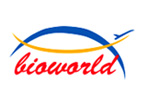Product Name :
CD258 Recombinant Protein Swiss-Prot :
O43557 Host :
E.coli Tag :
Amino acid Sequence :
LQLHWRLGEMVTRLPDGPAGSWEQLIQERRSHEVNPAAHLTGANSSLTGSGGPLLWETQLGLAFLRGLSYHDGALVVTKAGYYYIYSKVQLGGVGCPLGLASTITHGLYKRTPRYPEELELLVSQQSPCGRATSSSRVWWDSSFLGGVVHLEAGEKVVVRVLDERLVRLRDGTRSYFGAFMV Restriction sites :
NdeI-XhoI Background :
Tumor necrosis factor superfamily member 14 (TNFSF14), also known as CD258 and LIGHT, is a cell surface type II transmembrane protein that is expressed as a homotrimer. The extracellular region can be cleaved to generate a soluble cytokine. TNFSF14 is a ligand for the receptors herpesvirus entry mediator (HVEM) and lymphotoxin receptor (LTR). TNFSF14 is expressed on activated NK cells, activated T cells, activated monocytes, immature DCs, and mast cells. TNFSF14 interactions with HVEM induce potent co-stimulatory signaling in T cells and trigger NK cells to produce IFN-γ via NF-κB RelA/p50 pathway signaling. TNFRSF14 produced by tumor-sensing NK cells aids in DC maturation, enabling de novo anti-tumor adaptive immune responses. TNFSF14-HVEM interactions are considered the main drivers of anti-tumor immune responses, whereas TNFSF14-LTR interactions have been characterized as maintaining the infrastructure that supports the anti-tumor response via lymphoid development and cancer cells’ susceptibility to the immune response. TNFSF14 induces the normalization of tumor vasculature, sensitizes tumor cells to IFN-γ-mediated apoptosis, and results in a more inflamed tumor microenvironment (TME). Due to its effects on the TME and anti-tumor immune cell responses, TNFSF14 is being investigated as a target for immunotherapeutic intervention in cancer. TNFSF14 has also been implicated in the development and pathogenesis of inflammatory bowel disease and airway remodeling leading to asthma. Soluble :
PBS, 4M Urea, PH7.4 Purification&Purity :
Transferred into competent cells and the supernatant was purified by NI column affinity chromatography and the purity is > 85% (by SDS-PAGE). Storage&Stability :
Store at 4°C short term. Aliquot and store at -20°C long term. Avoid freeze-thaw cycles. Expression vector :
pet-22b(+) BiowMW :
~20kDa Note :
For research use only, not for use in diagnostic procedure. concentration :
CD258 Recombinant Protein Swiss-Prot :
O43557 Host :
E.coli Tag :
Amino acid Sequence :
LQLHWRLGEMVTRLPDGPAGSWEQLIQERRSHEVNPAAHLTGANSSLTGSGGPLLWETQLGLAFLRGLSYHDGALVVTKAGYYYIYSKVQLGGVGCPLGLASTITHGLYKRTPRYPEELELLVSQQSPCGRATSSSRVWWDSSFLGGVVHLEAGEKVVVRVLDERLVRLRDGTRSYFGAFMV Restriction sites :
NdeI-XhoI Background :
Tumor necrosis factor superfamily member 14 (TNFSF14), also known as CD258 and LIGHT, is a cell surface type II transmembrane protein that is expressed as a homotrimer. The extracellular region can be cleaved to generate a soluble cytokine. TNFSF14 is a ligand for the receptors herpesvirus entry mediator (HVEM) and lymphotoxin receptor (LTR). TNFSF14 is expressed on activated NK cells, activated T cells, activated monocytes, immature DCs, and mast cells. TNFSF14 interactions with HVEM induce potent co-stimulatory signaling in T cells and trigger NK cells to produce IFN-γ via NF-κB RelA/p50 pathway signaling. TNFRSF14 produced by tumor-sensing NK cells aids in DC maturation, enabling de novo anti-tumor adaptive immune responses. TNFSF14-HVEM interactions are considered the main drivers of anti-tumor immune responses, whereas TNFSF14-LTR interactions have been characterized as maintaining the infrastructure that supports the anti-tumor response via lymphoid development and cancer cells’ susceptibility to the immune response. TNFSF14 induces the normalization of tumor vasculature, sensitizes tumor cells to IFN-γ-mediated apoptosis, and results in a more inflamed tumor microenvironment (TME). Due to its effects on the TME and anti-tumor immune cell responses, TNFSF14 is being investigated as a target for immunotherapeutic intervention in cancer. TNFSF14 has also been implicated in the development and pathogenesis of inflammatory bowel disease and airway remodeling leading to asthma. Soluble :
PBS, 4M Urea, PH7.4 Purification&Purity :
Transferred into competent cells and the supernatant was purified by NI column affinity chromatography and the purity is > 85% (by SDS-PAGE). Storage&Stability :
Store at 4°C short term. Aliquot and store at -20°C long term. Avoid freeze-thaw cycles. Expression vector :
pet-22b(+) BiowMW :
~20kDa Note :
For research use only, not for use in diagnostic procedure. concentration :
Blocking peptide available as NCP0400P

 CD258 Recombinant Protein
CD258 Recombinant Protein 
 Datasheet
Datasheet COA
COA MSDS
MSDS SHIP
SHIP